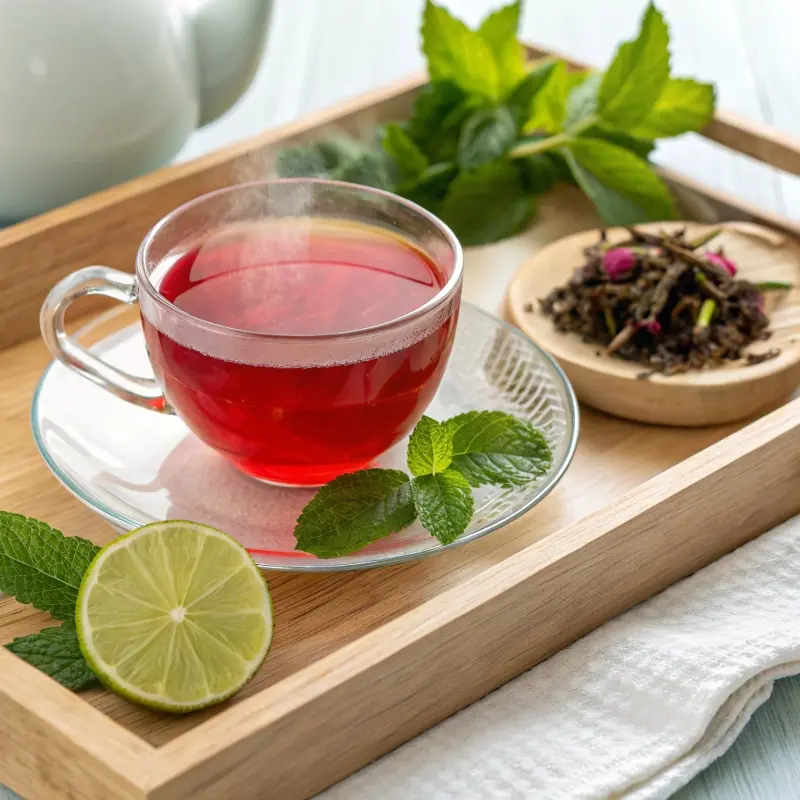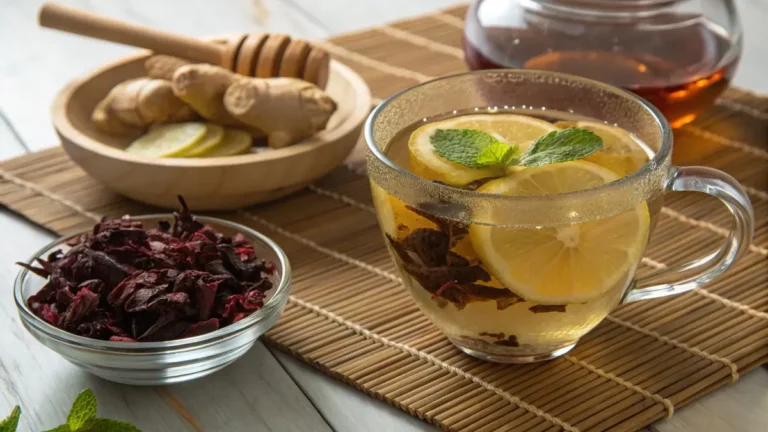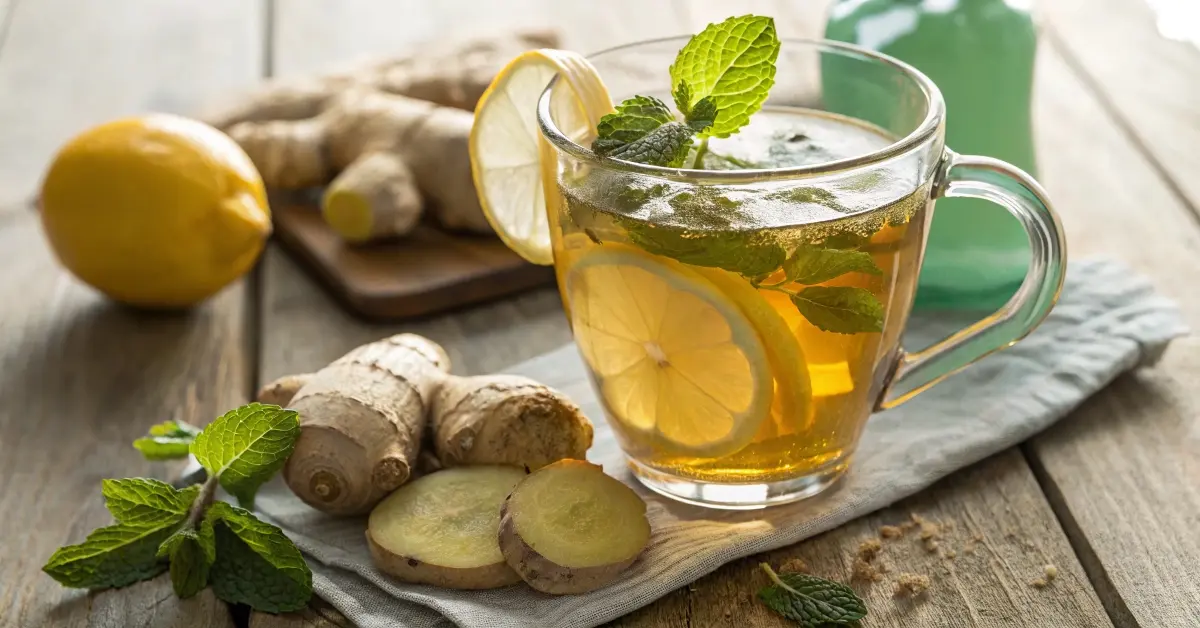Table of Contents
New to keto? Start with our Keto Diet for Beginners: Simple American Guide to Start Today for the full basics, then come back to these recipes.
What Is Bariatric Tea recipe ?
Recovering after bariatric surgery taught me that hydration can feel like hard work—especially when your stomach’s on a healing schedule. That’s how I found comfort in bariatric tea recipe, a simple yet soothing beverage that became part of my routine.
So, what exactly is bariatric tea recipe ? It’s traditionally a blend of green tea (or herbal tea), a slice of fresh lemon, and a bit of grated ginger—three basic ingredients that support hydration, digestion, and gentle flavor. You may also see variations including peppermint, turmeric, or other mild spices
By keeping it gentle—no caffeine overload, no dairy—you support your stomach’s healing lining, avoid bloating, and still get something comforting to sip throughout the day.
This drink isn’t just about volume; it’s about purpose. In Part 2, I’ll explain what bariatric tea recipe is good for, including digestion, blood sugar stabilization, and inflammation support. Then we’ll explore how certain teas may aid in fat metabolism, what types might help burn belly fat, and reveal that mysterious “red” ingredient often featured in bariatric-friendly blends.
If you’re tracking hydration goals, managing post-surgery discomfort, or craving warm beverages that do more than taste good, this article is for you. Let’s begin with the benefits.

Why It’s Good – All the Benefits
After surgery, every sip counts. Bariatric tea recipe doesn’t just hydrate—it heals. From easing digestion to calming inflammation, its simple ingredients offer surprisingly powerful benefits for post-op recovery and long-term wellness.
So, what is a bariatric tea recipe good for? First, it supports hydration, which is essential after any bariatric procedure when water intake needs to be steady but gentle. Sipping warm tea helps meet fluid goals without overwhelming your stomach.
Second, the typical ingredients in bariatric tea recipe—like green tea, ginger, lemon, or peppermint—are well known to ease digestive discomfort. Ginger reduces nausea and bloating, lemon provides a touch of vitamin C, and green tea contains antioxidants that may lower inflammation and support the immune system. Together, they create a soothing, gut-friendly combo that many patients rely on during the first months of recovery.
There’s also a subtle metabolic benefit. Green tea and ginger may help support blood sugar regulation and fat oxidation—helpful for those aiming to maintain healthy weight loss post-surgery. While not a cure-all, these effects align well with bariatric goals, especially when combined with a clean diet and activity.
Finally, many herbal versions of bariatric tea recipe are naturally caffeine-free and gentle on sensitive stomachs, making them ideal for sipping throughout the day or evening.
Whether you’re just beginning your post-surgery journey or exploring better drink options for weight loss and gut health, bariatric tea recipe is a natural ally. And in the next section, we’ll tackle a popular question: What tea burns belly fat all day? The answer may surprise you.
Belly-Fat & Metabolism Support
We’ve all seen the claims: “this tea melts belly fat!” But when it comes to bariatric tea recipe, the real magic lies in its metabolic support—not instant miracles. Still, certain teas can gently enhance fat oxidation and energy balance, especially when paired with a balanced post-surgery lifestyle.
So, what tea burns belly fat all day? The answer usually starts with green tea. It’s been studied for its natural caffeine and catechins, particularly EGCG, which may slightly increase calorie burn and promote fat breakdown. That’s why green tea often forms the base of bariatric-friendly brews.
Another option gaining traction is oolong tea—a traditional Chinese tea partially fermented and packed with antioxidants. Some research suggests oolong can enhance metabolism more effectively than green tea alone. Still, both are mild enough to support a sensitive post-op digestive system when consumed in moderation.
If you’re caffeine-sensitive, ginger tea or peppermint tea can also help. While they don’t directly burn fat, they reduce bloating and ease digestion, which makes you feel lighter and more energized. Inflammation reduction is key too—lowering inflammation can improve metabolic function and insulin sensitivity, both important after bariatric surgery.
It’s important to understand that bariatric tea recipe supports your efforts—it doesn’t replace nutrition, protein intake, or movement. Think of it as a companion on your wellness journey.
In our next section, we’ll dig into that mysterious red ingredient often seen in fat-burning tea blends. Is it hibiscus? Rooibos? Or something else entirely? Let’s explore.
The Red Ingredient Mystery
If you’ve ever seen a deep red bariatric tea recipe in your support group or Pinterest feed, you’ve probably wondered: what is the red ingredient in bariatric tea recipe ? That bold color usually comes from one of two powerful herbal ingredients—hibiscus or rooibos—both caffeine-free and packed with benefits.
Hibiscus tea, made from dried hibiscus petals, is a common choice. Its tart flavor, similar to cranberry, isn’t just refreshing—it’s functional. Studies show hibiscus may support lower blood pressure, improve cholesterol levels, and help reduce abdominal fat. Plus, its vivid red hue makes it a popular visual choice for bariatric blends aiming to be both appealing and beneficial.
Then there’s rooibos, often called red bush tea. Naturally sweet and slightly nutty, rooibos contains unique antioxidants like aspalathin that may support blood sugar regulation and stress reduction—both key for weight management. Rooibos also contains no caffeine, making it ideal for sipping in the evening without disrupting sleep.
You might also encounter red raspberry leaf in some blends. While not technically “red tea,” it can add a rosy tint and is often used for its anti-inflammatory and hormonal balancing properties.

So, the next time you see that brilliant ruby-colored tea, know it’s more than just pretty. It’s likely infused with hibiscus or rooibos—ingredients that not only taste great but help you stay on track with your post-surgery goals.
Now that we’ve uncovered every layer of bariatric tea recipe, let’s answer some final questions and wrap it all up with easy takeaways.
FAQ
What are the three ingredients in bariatric tea?
A classic bariatric tea recipe usually contains green tea or an herbal base, fresh lemon juice or slices, and grated ginger. Some variations may include peppermint or turmeric for added digestive support.
What is a bariatric tea good for?
Bariatric tea recipe supports hydration, eases digestion, reduces inflammation, and can mildly enhance metabolism—making it especially helpful after bariatric surgery or during weight loss.
What tea burns belly fat all day?
Green tea and oolong tea are known for their potential fat-burning properties, thanks to natural antioxidants and mild caffeine content. While not magic, they may gently boost metabolism over time.
What is the red ingredient in bariatric tea?
The red color typically comes from hibiscus or rooibos. Both are caffeine-free, antioxidant-rich, and support heart health, blood sugar balance, and digestion.

Bariatric Tea Recipe – Simple Ingredients, Real Digestive Support
This soothing bariatric tea recipe supports digestion, eases inflammation, and gently boosts hydration with simple, natural ingredients ideal for post-op recovery.
- Total Time: 10 minutes
- Yield: 1 cup
Ingredients
1 green tea bag or 1 tsp loose-leaf green tea
1 tsp grated fresh ginger
2 slices lemon or 1 tsp lemon juice
1 tsp dried hibiscus (optional)
1 cup hot water
Optional: fresh mint, raw honey (if approved)
Instructions
1. Boil water and allow it to cool slightly below boiling.
2. Add green tea, ginger, and hibiscus (if using) to a mug or teapot.
3. Steep for 3–5 minutes until desired strength.
4. Add lemon slices and optional mint or honey.
5. Strain if using loose-leaf ingredients and enjoy warm.
Notes
For caffeine-free options, use rooibos or peppermint tea instead of green tea.
Avoid sweeteners early post-op unless approved by your provider.
Drink slowly in small sips to stay within fluid guidelines.
- Prep Time: 5 minutes
- Cook Time: 5 minutes
- Category: Beverage
- Method: Steeping
- Cuisine: Herbal
Conclusion
Whether you’re newly post-op or simply exploring better-for-you beverages, bariatric tea recipe is a gentle, purposeful way to support your health goals. With ingredients that soothe, energize, and heal—like ginger, lemon, hibiscus, and green tea—it becomes more than a drink. It’s a habit worth savoring.
Looking for low-carb snacks to pair with your sips? Try our Keto Fried Pickle Balls for a crispy side, or dip into our Chipotle Adobo Ranch for a smoky, creamy boost between meals.

